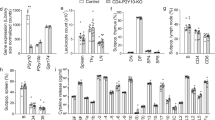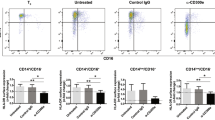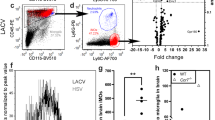Abstract
APUTATIVE chemokine receptor that we previously cloned and termed LESTR1 has recently been shown to function as a co-receptor (termed fusin) for lymphocyte-tropic HIV-1 strains2. Cells expressing CD4 became permissive to infection with T-cell-line-adapted HIV-1 strains of the syncytium-inducing phenotype after transfection with LESTR/fusin complementary DNA. We report here the identification of a human chemokine of the CXC type, stromal cell-derived factor 1 (SDF-1), as the natural ligand for LESTR/fusin, and we propose the term CXCR-4 for this receptor, in keeping with the new chemokine-receptor nomenclature. SDF-1 activates Chinese hamster ovary (CHO) cells transfected with CXCR-4 cDNA as well as blood leukocytes and lymphocytes. In cell lines expressing CXCR-4 and CD4, and in blood lymphocytes, SDF-1 is a powerful inhibitor of infection by lymphocyte-tropic HIV-1 strains, whereas the CC chemokines RANTES, MIP-lα and MIP-1β, which were shown previously to prevent infection with primary, monocyte-tropic viruses3, are inactive. In combination with CC chemokines, which block the infection with monocyte/macrophage-tropic viruses, SDF-1 could help to decrease virus load and prevent the emergence of the syncytium-inducing viruses which are characteristic of the late stages of AIDS4.
This is a preview of subscription content, access via your institution
Access options
Subscribe to this journal
Receive 51 print issues and online access
$199.00 per year
only $3.90 per issue
Buy this article
- Purchase on SpringerLink
- Instant access to full article PDF
Prices may be subject to local taxes which are calculated during checkout
Similar content being viewed by others
References
Loetscher, M., Geiser, T., O'Reilly, T., Zwahlen, R., Baggiolini, M. & Moser, B. J. Biol. chem. 269, 232–237 (1994).
Feng, Y., Broder, C. C., Kennedy, P. E. & Berger, E. A. Science 272, 872–877 (1996).
Cocchi, F. et al. Science 270, 1811–1815 (1995).
Weiss, R. A. Science 272, 1885–1886 (1996).
Tashiro, K. et al. Science 261, 600–603 (1993).
Nagasawa, T., Kikutani, H. & Kishimoto, T. Proc. Natl Aced. Sd. USA 91, 2305–2309 (1994).
Bleul, C. C., Fuhlbigge, R. C., Casasnovas, J. M., Aiuti, A. & Springer, T. A. J. Exp. Med. (in the press).
Baggiolini, M., Dewald, B. & Moser, B. Adv. Immunol. 55, 97–179 (1994).
Nomura, H., Nielsen, B. W. & Matsushima, K. Int. Immunol. 5, 1239–1249 (1993).
Adachi, A. et al. J. Virol. 59, 284–291 (1986).
Deng, H. K. et al. Nature 381, 661–666 (1996).
Dragic, T. et al. Nature 381, 667–673 (1996).
Alkhatib, G. et al. Science 272, 1955–1958 (1996).
Choe, H. et al. Cell 85, 1135–1148 (1996).
Doranz, B. J. et al. Cell 85, 1149–1158 (1996).
Yee, J. K. et al. Proc. Natl Aced. Sci. USA 91, 9564–9568 (1994).
Jazin, E. E. et al. Regul. Pept. 47, 247–258 (1993).
Clark-Lewis, I. et al. Biochemistry 30, 3128–3135 (1991).
Peveri, P., Walz, A., Dewald, B. & Baggiolini, M. J. Exp.Med. 167, 1547–1559 (1988).
Uguccioni, M., D'Apuzzo, M., Loetscher, M., Dewald, B. & Baggiolini, M. Eur. J. Immunol. 25, 64–68 (1995).
Colotta, F., Peri, G., Villa, A. & Mantovani, A. J. Immunol. 132, 936–944 (1984).
von Tscharner, V., Prod'hom, B., Baggiolini, M. & Reuter, H. Nature 324, 369–372 (1986).
Cann, A. J. et al. J. Virol. 64, 4735–4742 (1992).
Li, Y. et al. J. Virol. 66, 6587 - (1992).
Clavel, F. & Charneau, P. J. Virol. 68, 1179–1185 (1994).
Jacque, J. M. et al. J. Virol. 70, 2930–2938 (1996).
Author information
Authors and Affiliations
Rights and permissions
About this article
Cite this article
Oberlin, E., Amara, A., Bachelerie, F. et al. The CXC chemokine SDF-1 is the ligand for LESTR/fusin and prevents infection by T-cell-line-adapted HIV-1. Nature 382, 833–835 (1996). https://doi.org/10.1038/382833a0
Received:
Accepted:
Issue Date:
DOI: https://doi.org/10.1038/382833a0



